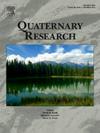Calibrating the Wisconsin in the eastern Great Lakes of North America using optically stimulated luminescence (OSL) dating of the Quaternary sediments at Sand Hill Park, north shore of Lake Erie, Ontario
IF 1.8
3区 地球科学
Q3 GEOGRAPHY, PHYSICAL
引用次数: 0
Abstract
Abstract The eastern Great Lakes Late Quaternary timescale is based on older thermoluminescence dates and on uncalibrated radiocarbon dates from extensive sections along the north shores of Lakes Erie and Ontario. New optically stimulated luminescence dates from Late Quaternary delta sediments from the north shores of Lake Erie at Sand Hills Park give consistent ages of 23.5 to 20.5 ka. This is 4 to 7 ka older than previously assigned based on lithologic correlation with 16.5 ka calibrated radiocarbon dated sediments 5 km to the west at Vanderven. On the existing eastern Great Lakes stratigraphy, it puts deposition of these Sand Hills Park sediments in the Erie interstadial and not in the fluctuating postglacial glacial retreat of the Mackinaw phase to which the Vanderven sediments belong. The Sand Hills delta and underlying diamicts must have been overridden by the Porty Bruce advance at 18 ka. IntCal20 calibration of existing radiocarbon ages suggests that the physical stratigraphic relations of the various Wisconsin units are accurate and that the existing timescale is simply too young.利用光学激发发光法(OSL)对安大略省伊利湖北岸沙丘公园第四纪沉积物进行定年,对北美东部五大湖的威斯康星进行校正
东部五大湖晚第四纪的时间尺度是基于更古老的热释光年代和伊利湖和安大略湖北岸广泛剖面的未经校准的放射性碳年代。来自沙山公园伊利湖北岸晚第四纪三角洲沉积物的新光学刺激发光日期给出了23.5 ~ 20.5 ka的一致年龄。这比先前根据与Vanderven以西5公里处16.5 ka校准的放射性碳定年沉积物的岩性对比而确定的年龄早4至7 ka。在现有的东部五大湖地层上,它把这些沙丘公园沉积物的沉积放在伊利间冰期,而不是在万德文沉积物所属的麦基诺期波动的冰川后退缩期。沙丘三角洲和下面的沙漠在18ka时肯定被布鲁斯党推进所覆盖。IntCal20对现有放射性碳年龄的校准表明,威斯康星各个单元的物理地层关系是准确的,现有的时间标度太年轻了。
本文章由计算机程序翻译,如有差异,请以英文原文为准。
求助全文
约1分钟内获得全文
求助全文
来源期刊

Quaternary Research
地学-地球科学综合
CiteScore
4.70
自引率
8.70%
发文量
57
审稿时长
3 months
期刊介绍:
Quaternary Research is an international journal devoted to the advancement of the interdisciplinary understanding of the Quaternary Period. We aim to publish articles of broad interest with relevance to more than one discipline, and that constitute a significant new contribution to Quaternary science. The journal’s scope is global, building on its nearly 50-year history in advancing the understanding of earth and human history through interdisciplinary study of the last 2.6 million years.
 求助内容:
求助内容: 应助结果提醒方式:
应助结果提醒方式:


